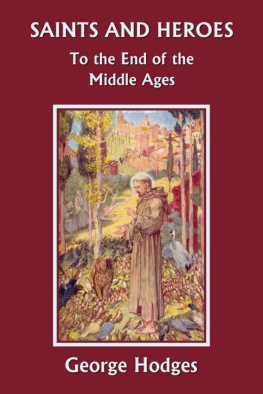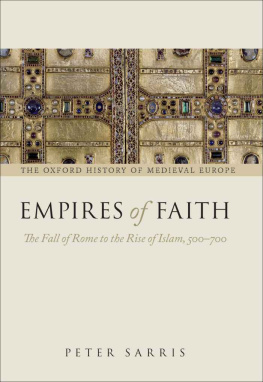George Hodges - The Early Church
Here you can read online George Hodges - The Early Church full text of the book (entire story) in english for free. Download pdf and epub, get meaning, cover and reviews about this ebook. year: 2007, publisher: Yesterdays Classics, genre: Religion. Description of the work, (preface) as well as reviews are available. Best literature library LitArk.com created for fans of good reading and offers a wide selection of genres:
Romance novel
Science fiction
Adventure
Detective
Science
History
Home and family
Prose
Art
Politics
Computer
Non-fiction
Religion
Business
Children
Humor
Choose a favorite category and find really read worthwhile books. Enjoy immersion in the world of imagination, feel the emotions of the characters or learn something new for yourself, make an fascinating discovery.
- Book:The Early Church
- Author:
- Publisher:Yesterdays Classics
- Genre:
- Year:2007
- Rating:5 / 5
- Favourites:Add to favourites
- Your mark:
- 100
- 1
- 2
- 3
- 4
- 5
The Early Church: summary, description and annotation
We offer to read an annotation, description, summary or preface (depends on what the author of the book "The Early Church" wrote himself). If you haven't found the necessary information about the book — write in the comments, we will try to find it.
The Early Church — read online for free the complete book (whole text) full work
Below is the text of the book, divided by pages. System saving the place of the last page read, allows you to conveniently read the book "The Early Church" online for free, without having to search again every time where you left off. Put a bookmark, and you can go to the page where you finished reading at any time.
Font size:
Interval:
Bookmark:
All rights reserved. No part of this book may be reproduced or retransmitted in any form or by any means without the written permission of the publisher.
This edition, first published in 2010 by Yesterday's Classics, an imprint of Yesterday's Classics, LLC, is an unabridged republication of the work originally published by Houghton Mifflin Company in 1915. This title is available in a print edition (ISBN 978-1-59915-196-0).
Yesterday's Classics republishes classic books for children from the golden age of children's literature, the era from 1880 to 1920. Many of our titles are offered in high-quality paperback editions, with text cast in modern easy-to-read type for today's readers. The illustrations from the original volumes are included except in those few cases where the quality of the original images is too low to make their reproduction feasible. Unless specified otherwise, color illustrations in the original volumes are rendered in black and white in our print editions.
These chapters began as Lowell Lectures in 1908. The lectures were given without manuscript, and have been repeated in that form in Cambridge, in Salem, in Springfield, in Providence, Rhode Island, and in Brooklyn, New York. The first, second, third, and fourth were then written out and read at the Berkeley Divinity School, Middletown, Connecticut, as the Mary H. Page Lectures for 1914. In like manner the sixth, seventh, eighth, and ninth were given at Kenyon College, Gambier, Ohio, as the Bedell Lectures for 1913. The tenth was given in 1913, at Ann Arbor, Michigan, on the Baldwin Foundation. Finally, the lectures, as they now appear, were repeated in 1914 at West Newport, California, at the Summer School conducted by the Commission on Christian Education of the Diocese of Los Angeles.
The following extracts from a communication in 1880 to the Trustees of Kenyon College indicate the intentions of Bishop and Mrs. Bedell, founders of the Bedell Lectureship:
We have consecrated and set apart for the service of God the sum of five thousand dollars, to be devoted to the establishment of a lecture or lectures in the Institutions at Gambier on the Evidences of Natural and Revealed Religion, or the Relations of Science and Religion.
The lecture or lectures shall be delivered biennally on Founders' Day (if such a day shall be established) or other appropriate time. During our lifetime, or the lifetime of either of us, the nomination of the lectureship shall rest with us.
The interest for two years on the fund, less the sum necessary to pay for the publication, shall be paid to the lecturer.
We express our preference that the lecture or lectures shall be delivered in the Church of the Holy Spirit, if such building be in existence; and shall be delivered in the presence of all the members of the Institutions under the authority of the Board. We ask that the day on which the lecture, or the first of each series of lectures, shall be delivered shall be a holiday.
We wish that the nomination to this Lectureship shall be restricted by no other consideration than the ability of the appointee to discharge the duty to the highest glory of God in the completest presentation of the subject.
The original sources from which a knowledge of this period is derived are readily accessible in translation. In The Ante-Nicene Fathers (8 vols.) the reader will find most of the writings of the Early Church under the Pagan Empire, to the year 325. A Select Library of the Nicene and Post-Nicene Fathers , in two Series (each of 14 vols.), contains the most important works of Christian writers from 325 till the beginning of the Middle Ages. The first series is given to Augustine and Chrysostom. The second series contains the books of the leaders of Christian thought and life from Athanasius to Gregory the Great. The Church History of Eusebius, extending to 324, has been translated and edited by Dr. A. C. McGiffert. The continuations of this history by Socrates (324-439), by Sozomon (324-425), and by Rufinus (324-395) are translated into English,Socrates and Sozomon in the Second Series of the Nicene and Post-Nicene Fathers . Dr. Joseph Cullen Ayer's Source Book for Ancient Church History contains significant extracts from the writers of this period, with interpretive comments. The first volume of the Cambridge Medieval History deals with the fifth century. Professor Gwatkin's Early Church History to 313 and Monsignor Duchesne's Early History of the Church are recent aids to an understanding of these times.
My friend and colleague, Professor Henry Bradford Washburn, has read these chapters in proof, and I am indebted to him for many helpful suggestions.
G EORGE H ODGES
E PISCOPAL T HEOLOGICAL S CHOOL
C AMBRIDGE, M ASSACHUSETTS.
T HE Roman world was bounded on the west by the Atlantic Ocean, on the north by the Rhine and the Danube, on the east by the Euphrates, on the south by the Desert of Sahara. The Egyptian world had been dependent on the Nile; the Assyrian and Chaldean world had been dependent on the Tigris and the Euphrates; the Roman world enclosed the Mediterranean Sea.
Outside of these boundaries lay the greater part of Africa, of Asia, and of Europe.
In Africa were savage people, whose descendants even to this day are separated from civilization by the wide barrier of the desert.
In Asia were three nations whose history antedated the time when Athens and Rome were country villages. With China and India, the Roman world was connected by an adventurous commerce. Every year merchantmen sailed down the Arabian Gulf and across the Indian Ocean to Ceylon. There they met traders from the ancient markets of the East, and returned with cargoes such as laded the ships of Solomon,"ivory and apes and peacocks," with spices, gems, and rich embroideries. But Persia was an enemy. Beyond the Euphrates the Persians remembered the day when they had ruled the world, and prayed for another Cyrus who should make them masters of the world again. They menaced Rome continually. Sometimes they succeeded in destroying Roman armies. Once they took a Roman emperor captive, and the rumor drifted back to Italy that the King of Persia, whenever he mounted his horse, stepped on the emperor's neck.
In Europe, on the wide plains of Russia, in the thick woods of Germany, hordes of barbarians, impelled by mysterious forces such as summon the tides and the birds, were threatening the South. Already, in the Old Testament, the Book of Zephaniah was filled with the terror of the Scythians; and in the New Testament, the Epistle to the Galatians was written to the people of a province which had been seized and settled by invading Gauls. The Rhine and the Danube, rising only thirty miles apart, made a boundary line between the empire and these tribes, guarded by the camps of the legions.
Between Italy and Greece, the deep cleft of the Adriatic Sea divided the Roman world into two parts. The divided parts differed in tradition and in language. In the Eastin Greece and Syria and Egyptthe Romans had conquered countries which had ancient and splendid traditions, and were more civilized than their conquerors. In the Westin Italy and Spain and Gaulthe Romans had overcome peoples few of whom had any history, and who had imitated the civilization and adopted the traditions of their masters. As for language, Greek was spoken by all persons of education in the Roman world during the first and second centuries of our era. Marcus Aurelius wrote his "Meditations" in Greek. It was not until the beginning of the fifth centuryalmost at the end of the period which comes within the compass of our present studythat the West had a satisfactory Latin Bible. Nevertheless, as time passed, the Latin language spread through the Greeks despised it; and by and by in the West Greek was forgotten. Thus the conditions were prepared for the political and theological misunderstandings which eventually divided the West and the East.
Font size:
Interval:
Bookmark:
Similar books «The Early Church»
Look at similar books to The Early Church. We have selected literature similar in name and meaning in the hope of providing readers with more options to find new, interesting, not yet read works.
Discussion, reviews of the book The Early Church and just readers' own opinions. Leave your comments, write what you think about the work, its meaning or the main characters. Specify what exactly you liked and what you didn't like, and why you think so.












